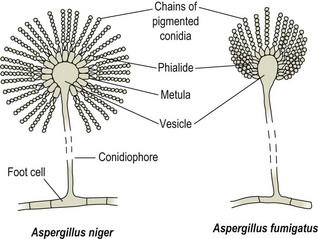Chapter 39 More than 190 species of Aspergillus have been formally recognized, most are harmless saprophytes. It is estimated that Apergillus fumigatus is responsible for 90–95% of aspergillosis infections in animals. Other Aspergillus species that occasionally cause infections are A. niger, A. flavus, A. terreus, A. deflectus, A. flavipes and possibly A. nidulans. Aspergillus flavus is more commonly involved in aflatoxicosis. Taxonomically the genus is placed in the phylum Ascomycota. For many species the sexual stage has not been identified. The sexual reproductive cycle of Aspergillus fumigatus was observed for the first time in recent years and the teleomorph named Neosartorya fumigata (O’Gorman et al. 2008). The Aspergillus species are rapidly growing, aerobic moulds with septate hyphae. Many have highly coloured colonies that range from bluish-green through yellow to black due to the profuse production of pigmented spores (conidia). The chains of small (2–3 µm) oval or spherical conidia are borne from the tips of phialides radially positioned over the surface of the swollen tip (vesicle) of the aerial hypha (conidiophore) which develops at right angles from specialized hyphal foot cells (Fig. 39.1). Aspergillus species can cause disease in several ways, they can be invasive, cause mycotoxicoses and are involved in allergic reactions in humans. Aspergillus fumigatus produces haemolysins, proteolytic enzymes and other toxic factors, in particular gliotoxin, a mycotoxin which has immunosuppressive properties. Infection is acquired from environmental sources, generally by inhalation or ingestion. It is an opportunistic pathogen depending on impaired, overwhelmed or by-passed host defences to permit hyphal invasion of tissues. In pulmonary infections, following spore inhalation, suppurative exudates accumulate in the bronchioles. The spores are small enough to be carried to the terminal parts of the bronchial tree. Mycelial growth may extend into blood vessels, leading to vasculitis, thrombus formation and dissemination to other parts of the body. Granulomas can develop in many body organs and are visible as yellowish-grey nodules. If A. fumigatus breaks out into an air space in the body, such as the air sacs in chickens, distorted fruiting heads can be formed (Fig. 39.2). Table 39.1 indicates the diseases that can be caused in animals by A. fumigatus. On rare occasions, other opportunistic fungi (Paecilomyces species, Penicillium species, Pseudallescheria boydii and Scedosporium apiospermum) may be isolated from lesions similar to those associated with Aspergillus species (Watt et al. 1995). Spores of Aspergillus fumigatus present in organic stable dust may act as an allergen and have been associated with cases of chronic obstructive pulmonary disease in horses. Table 39.1 Diseases caused by Aspergillus species in veterinary species
Aspergillus species and Pneumocystis carinii
Aspergillus species
Pathogenesis
Host
Disease
Comments
Cattle
Mycotic abortion
Sporadic occurrence, thickened, leathery placenta and raised plaques on skin of foetus
Mycotic mastitis
Chronic, progressive infection associated with use of contaminated intramammmary antibiotic tubes
Intestinal aspergillosis
Described occasionally in calves
Mycotic pneumonia
Rare, in housed calves
Horses
Guttural pouch mycosis
Sporadic, often unilateral, necrotizing infection of guttural pouch. May involve carotid blood vessels and glossopharyngeal nerve
Nasal granuloma
Presents as nasal discharge and interference with breathing
Keratomycosis
May follow on from ocular trauma
Intestinal aspergillosis
Described occasionally in foals
Dogs
Nasal aspergillosis
Sporadic occurrence, usually in young to middle-aged dolichocephalic breeds. Persistent nasal discharge. May involve turbinate bones and paranasal sinuses
Otitis externa
Occurs as part of mixed infection
Systemic aspergillosis
Rare, recorded in German Shepherd breed particularly. Osteomyelitis is often a feature
Birds
Brooder pneumonia
Respiratory infection that occurs in newly hatched chicks exposed to high numbers of spores in incubators
Aspergillosis
Pneumonia and air sacculitis in birds exposed to aerosols of spores from contaminated litter or feed. May occur in outbreaks where birds are stressed, for example, penguins kept in warm environments. Infection may become disseminated to other internal organs ![]()
Stay updated, free articles. Join our Telegram channel

Full access? Get Clinical Tree


Aspergillus species and Pneumocystis carinii
Only gold members can continue reading. Log In or Register to continue

